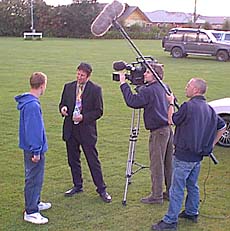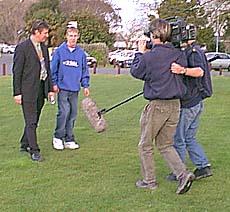Boom Microphone
 The boom microphone is very popular in film and television production. A directional mic is mounted on a boom arm and positioned just out of camera frame, as shown on the right. The cable is wrapped once or twice around the boom arm.
The boom microphone is very popular in film and television production. A directional mic is mounted on a boom arm and positioned just out of camera frame, as shown on the right. The cable is wrapped once or twice around the boom arm.Booms have the advantage of freeing up subjects from having to worry about microphones. They can move freely without disturbing the sound, and concerns about microphone technique are eliminated.
You can make a simple boom from just about anything which is the right shape. A microphone stand with its legs removed is a good option, or even a broomstick or fishing pole.
A good boom will have some sort of isolating mechanism for the microphone to prevent vibrations being transferred to the mic. This may involve elastic suspensions, foam padding, etc.
 The distance between the microphone and subject must be carefully controlled. The mic must be as close as possible without any chance of getting in frame (you might want to allow a safety margin in case the framing changes unexpectedly). It must also maintain a reasonably consistent distance to avoid fluctuating audio levels.
The distance between the microphone and subject must be carefully controlled. The mic must be as close as possible without any chance of getting in frame (you might want to allow a safety margin in case the framing changes unexpectedly). It must also maintain a reasonably consistent distance to avoid fluctuating audio levels.Make sure the boom doesn't cast a show on the scene.
In the example on the right, the sound operator is also acting as a guide for the camera operator as they walk backwards, keeping a constant distance from the walking subjects.


The Boom Pole Operator
For most large film or digital video scenes you are going to have to use a large shotgun microphone. A shotgun microphone is a specific type of directional microphone that will absorb most of the sound through the very front. The most standard way to employ this shotgun microphone in large film or digital video scenes is to use a boom pole. The boom pole is a long pole held by the boom pole operator into the area where it needs to be to pick up the sound you are looking for. The position of the boom operator is a serious career option for many people in the professional film industry as they are employed on every film and must have a serious set of skills. Here are a few tips for successfully acting as a boom operator.
Video Equipment
The first tip that you should always follow as a boom operator is to keep the right equipment on you. A standard for boom operators in the film industry is to include hairballs, which are ties for pony tails with marbles on them, to help secure wires that you are clipping to the boom pole. These hairballs should stay in the boom operators equipment bag, yet they are only going to be employed if the boom pole being used does not use internal wiring.
You are also going to need a carabiner to clip to your belt. This carabineer will then be used to direct the cables from the boom pole. Since you are going to have to be monitoring the sound that you are picking up make sure that you have a good pair of noise canceling headphones to pick up the sound.
Beyond these pieces of "video" equipment you are really going to need an adequate boom pole. Boom poles should be matte black so that they do not reflect light, and they also need to be fairly rigid. It is always best to get an actual boom pole and not to just try to construct one on your own. Also make sure that there are extra long XLR cables and that the sound mixing device is adequate.
You are also going to need a carabiner to clip to your belt. This carabineer will then be used to direct the cables from the boom pole. Since you are going to have to be monitoring the sound that you are picking up make sure that you have a good pair of noise canceling headphones to pick up the sound.
Beyond these pieces of "video" equipment you are really going to need an adequate boom pole. Boom poles should be matte black so that they do not reflect light, and they also need to be fairly rigid. It is always best to get an actual boom pole and not to just try to construct one on your own. Also make sure that there are extra long XLR cables and that the sound mixing device is adequate.
H Position
When operating a boom you are going to want to keep the boom above your head in an "H" position most of the time. The "H" position will keep the boom pole perpendicular to your body and will extend the pole away from you. Do not try to lean the boom pole on things or leverage it in odd ways as this can damage the boom pole and affect the sound quality. If you hold too far to the end you can end up bending, and eventually breaking, the boom pole.
Telescoping
When you are telescoping the boom pole, which means extending it at its joint, you should never go full length. The reason for this is the same as with positioning yourself in relation to the boom pole: it can put unneeded pressure on the pole and eventually cause it to snap.
Holding Pattern
Holding the boom pole for long periods of time can get very trying. Do not expect that you will be able to hold the boom pole in the "H" position for more than a few minutes maximum. This is one of the considerations director's make when constructing how long of takes they want. This is going to be incredibly true if the microphone is close to the frame.
Microphone
The quality of the microphone is obviously going to affect the position of the boom pole. Most directional shotgun microphones need to be pointed directly at the sound source and it is best to get it as close as possible without getting the microphone into the digital video camera's frame or distracting the talent.
The Script
The boom operator must have memorized the script as they will have to know the lines they are picking up with the microphone. This is especially true when people are talking as the boom operator is going to want to rotate to pick up the sound better between people. Unless he or she has the rhythm down they are not going to be able to do this effectively.
No comments:
Post a Comment